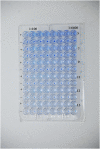Modifications in a Reference Freeze-Dried Direct Agglutination Test to Improve Visceral Leishmaniasis Detection
- PMID: 32043445
- PMCID: PMC7124908
- DOI: 10.4269/ajtmh.19-0745
Modifications in a Reference Freeze-Dried Direct Agglutination Test to Improve Visceral Leishmaniasis Detection
Abstract
Currently, a significantly lower temperature (35°C) than initially established (56°C) is indicated as the maximum temperature storage for the commercial reference visceral leishmaniasis (VL) freeze-dried direct agglutination test (FD-DAT). Despite an approximately 50% loss in the number of promastigotes in an FD-DAT batch that expired 7 years earlier, the promastigotes maintained a similar morphology to the equivalent valid batch implying most likely that auto-agglutination, rather than aging, is the main reason for expiry. The substitution of normal saline which was initially recommended for reconstitution, by citrate-saline/formaldehyde (CSF) as an anti-clumping/preservative agent resulted in restoration of validity comparable with that of the freeze-dried original or the liquid direct agglutination test (LQ-DAT) version (Friedman ANOVA test = 1.0588; P = 0.5890). Following a similar reconstitution procedure as for the 7-year expired antigen, using significantly lower promastigote concentration (1.4 × 107/mL) than in the non-expired (9.0 × 107/mL), good reliability for VL detection and stability at 4°C (> 12 months) were achieved. In comparison with the original version using normal saline ($32.0/vial), the cost-effectiveness of the FD-DAT was appreciably improved by the CSF incorporation and lowering of promastigote concentration per unit suspension medium ($12.8/vial). With diagnostic reliability comparable with the full-out titration used, FD-DAT procedure based on single sample dilution at the VL cutoff (1:3,200) permitted the use of significantly smaller antigen volumes (0.1 mL vs. > 1.5 mL), therefore contributing to a further reduction in the application cost. The successful replacement of β-mercaptoethanol (β-ME) by urea (T = 21.00; P = 0.0868) provided the required safety for the test procedure similar to the widely applied LQ-DAT.
Figures

References
-
- Boelaert M, Bhattacharya S, Chappuis F, El Safi SH, Hailu A, Mondal D, Rijal S, Sundar S, Wasunna M, Peeling RW, 2007. Evaluation of rapid diagnostic tests: visceral leishmaniasis. Nat Rev Microbiol 5: S30–S39.
-
- Mahamoud A, Osman HA, Abass EM, Agib A, Madi RR, Santos SJ, el Harith A, 2018. Identification of an area predominantly endemic for childhood and adolescent visceral leishmaniasis in central Sudan. Acta Trop 178: 142–147. - PubMed
-
- Mahamoud A, Awad Y, Osman HA, Agib A, Madi RR, Semiao-Santos SJ, el Harith A, 2018. User and environment friendly direct agglutination test for diagnosis of visceral leishmaniasis: exclusion of formaldehyde and β-mercaptoethanol in test execution. J Med Microbiol 67: 1731–1736. - PubMed
MeSH terms
Substances
LinkOut - more resources
Full Text Sources

